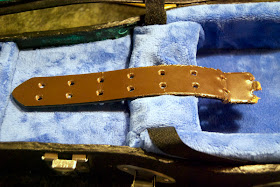What are you going to be eating on May 26? This has been the topic of many conversations in our house. On that date, Season 4 of Arrested Development will be released, all at once, on Netflix.
We talked about a few possibilities for our family viewing party: hot ham water, candy beans, juice...but really, there is only one sensible choice, and that is frozen bananas. The banana stand is at the heart of the Bluth Company, after all. And while no one in our family would really enjoy cornballs or mayoneggs, there is no one who doesn't like frozen bananas.
Chocolate-Covered Frozen Bananas
You need: bananas, chocolate, butter, popsicle or caramel apple sticks and (optional) nuts. Ideally, the bananas would be slightly riper than shown here. The stick will split a green banana, but will sink in nicely to a lightly freckled one.
We have one child who loves almonds, and one who doesn't like nuts at all, so I alternate between both plain and crunchy bananas (ie, nuts and no-nuts).

Cut the bananas in half, push the stick up the base, and place them on a tray to freeze for at least half an hour, and up to overnight.
Meanwhile, chop the nuts.
When the bananas are frozen, melt the chocolate over a double boiler (or in a pot nestled in a larger pot) and add enough butter to bring it to the consistency of, say, mayonnaise. Chocolate melted alone will be too thick to coat easily.
Because I don't have a dipping pot, I spread the chocolate on the bananas with a frosting spatula, seen above. Then, depending on your preference, you can either roll the banana in nuts or place it back on the tray to freeze again. But work quickly, as the frozen banana starts the process of hardening the chocolate almost immediately.
That's pretty much all there is to it. Whether or not you watch Arrested Development, a frozen banana is just about the perfect treat on a hot summer afternoon.






















































